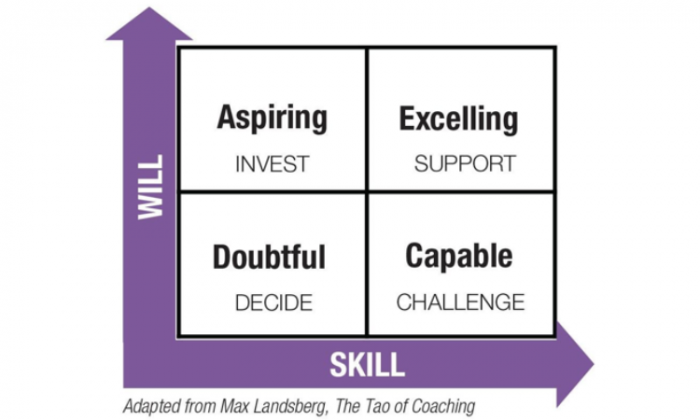Leading Your Sales Team By Understanding Where They Are On This Axis

Every sales team is made up of individuals with different strengths and weaknesses, but too many sales managers try to run their teams as if they’re a standardized block.
It’s easy to understand why. Sales management is a high-stress job that can force people to become crisis-chasing firefighters instead of the strategic coaches their companies truly need. With their time in such short supply, sales managers resort to one-size-fits-all coaching sessions for their teams.
Most of those so-called coaching sessions are focused on forecasting and pipeline. What is needed is the developmental coaching that leads to higher performance.
Yet sellers are definitely not the same. They have varying skills and motivations.
A crucial step to developing and coaching talent is to understand where individuals stand, where they can go — and how a manager can lead them there.
The Axis to Excellence
My favorite way to evaluate individuals on a team is to draw a classic graph with two axes, X and Y, one for the character trait of Will and one for the individual’s Skill. Will goes straight up — the Y axis — and Skill goes across the bottom, the X axis.

MAX LANDSBERG – MORE FOR YOU
The plan is to rate the Skill and Will of each team member. Place a dot on the graph where the two ratings intersect for each individual. Identify each dot with the seller’s initials. Finally, draw an arrow in the direction each seller is trending.
The Most Trusted Leadership Company
Learn how your organization can use our people, content, and technology to create collective action and meaningful change.

A few words of advice on how to form your ratings:
Start with willingness — how passionate is the person to engage in the job? You can call it the, “Hey coach, put me in the game” factor. Are they enthusiastic and up to the challenge? Then plot these people far to the right on the Will axis. If they are more cynical, burned out, and not as willing to engage, then they go closer to the zero point.
Next, evaluate skill. Remember that skill is not the same as experience. The key here is to evaluate observed skill, not something on the resume or something the team member has talked about, but something you have actually observed and witnessed — or one of your managers has —in the course of a sale or project.
Once the Will and Skill of a team member is plotted on the graph, draw an arrow to indicate the direction each seller is trending toward.
Time for Analysis
In general, it’s easier to deal with skill gaps. Training and education are fixable problems, but it’s tough to deal with willingness gaps. Managers should be more lenient on the skill than on the will side.
Your chart may have some low-skill, low-will people. We call them the Doubtfuls. They’re consuming resources, they’re not a good fit, and if they can’t move up, it may be time for these sellers to move on from your company.
Sellers with high will but low skill are ripe for more attention. They have enthusiasm and a great attitude. It’s up to the manager to give them better tools for the job. Sales managers can reap large rewards from an investment in people who are high-will, low-skill.
The most pressing area, however, includes sellers who are high skill but low will. They have a history of excellent performance, but something changed — a new role, a revised compensation plan, a different manager, a company acquisition.
The people in this area are the ones who should get first attention. It is a flashing danger signal to have top performers who are aimless and disengaged. Unless something changes, these people are likely to walk out the door. Managers need to figure out what is going wrong with these people and fix it — fast.
The final group includes the stars of the sales team, the high skill, high will people. They are doing a great job, excelling. They set a great example.
With more pressing problems elsewhere, sales managers can be tempted to ignore their best people. That is a giant mistake. The top sellers need just a small amount of support. Managers should check in frequently to remove barriers. The idea is to encourage and engage and stretch them without becoming overly dependent on them. It’s a fine balance.
Finally, sales managers need to consider the impact of the overall chart. Where is the bulk of the sales team? Lots of dots in one tough area, especially high-skill, low-will, is a sure signal of trouble ahead.
Sales team management is too complex to be done with a single gear for everyone. Coaching based on sellers’ skill and will is a streamlined way to focus on the individual issues that matter — and the areas that will produce the best results for the organization.








